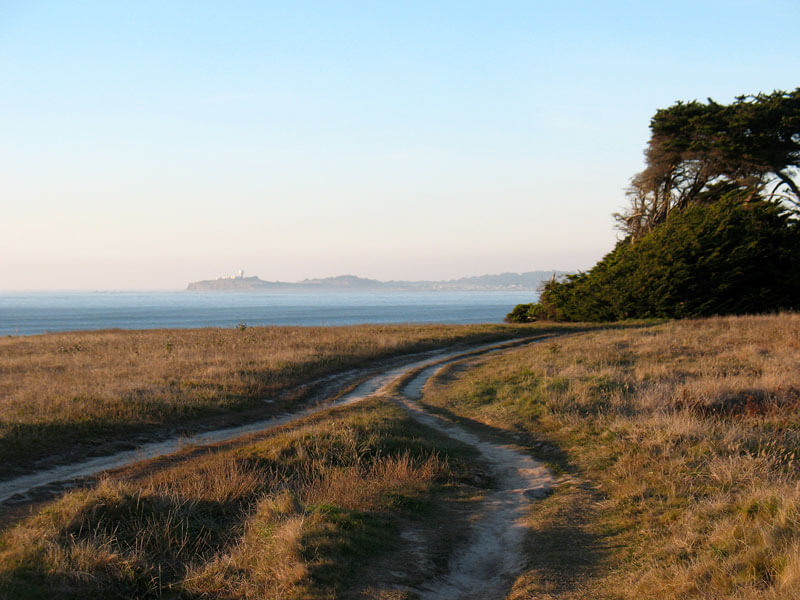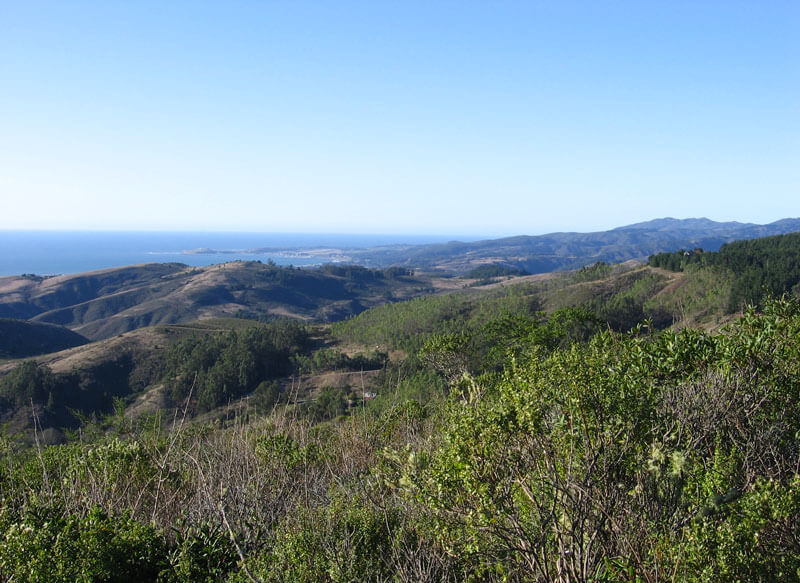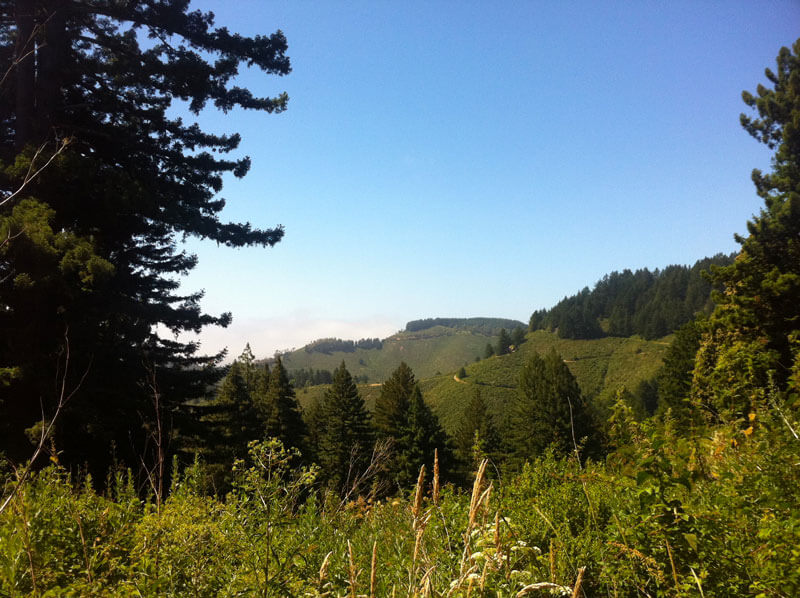Birds and Birding in the Santa Cruz Mountains
photo by M. Kahn
How to Bird the Redwoods and Coast
By Alvaro Jaramillo, Alvaro’s Adventures
Have you considered birding or birdwatching? Not sure how you start? Well, I have good news: it is easy and very little is needed to get started. The first thing is to just pay attention when you are outside, intentionally look and listen. Paying attention to birds will bring a new perspective to your outdoor hikes and walks. Birding not only fills you with the sights and sounds of these amazing and common inhabitants of the forest, but it will make you focus at times in a deeply contemplative and wonderful way. Watching birds can become a tad addictive and may even get you walking more often. Why birds? Well, they are everywhere, they fly, they are often colorful, and they sing. Much of birdwatching is actually bird listening, and unlike much of the life in the forest, they are easy to find.

What Do You Need?
You could begin birding with just your eyes and ears, but as you gain interest, optics and references help.
Binoculars
Binoculars come in all budgets, and vary in their optical quality, size and weight. The better the quality, the crisper the image and number of colors you perceive. Most birders use magnification of 8 or 10x. How a binocular fits in your hands and how the eyepieces adjust if you are an eyeglass wearer are important. So, you may want to try binoculars in person, such as Los Gatos Birdwatcher or Birder’s Garden, rather than just order them online.
Field Guides
A field guide is a book that helps you identify, or name, a bird. The field guide format can be particularly useful to compare similar species like The Sibley Field Guide to Birds of Western North America. As a beginner, you may want to use a book that includes only common species in California, such as the American Birding Association Field Guide to Birds of California, making it a tad less complex to find the bird you are looking for. The Cornell Laboratory of Ornithology offers a free app called Merlin which helps you identify birds, including sound identification.
Why care about the name of the bird? Well, it is an avenue to understanding. Once you know what it is, then you have context to learn about where it lives, the habitat it takes, migration, and other details which help you enjoy both the bird, and your outing in nature. As you become proficient, you can then input your sightings to eBird, a public database that is used by birders and conservationists throughout the world.
Where Should You Look?
We have the luxury here in the Bay Area of having the ocean as well as mountains. Both affect climate, and create habitat differences like coastal versus bayside slopes and how high up you are on the mountain. Each habitat has different birds, moving from lowlands to uplands on the coast slope will give you a great diversity of birds to look for. The Sequoia Audubon Society has created a wonderful site that maps and details birding spots in San Mateo County.
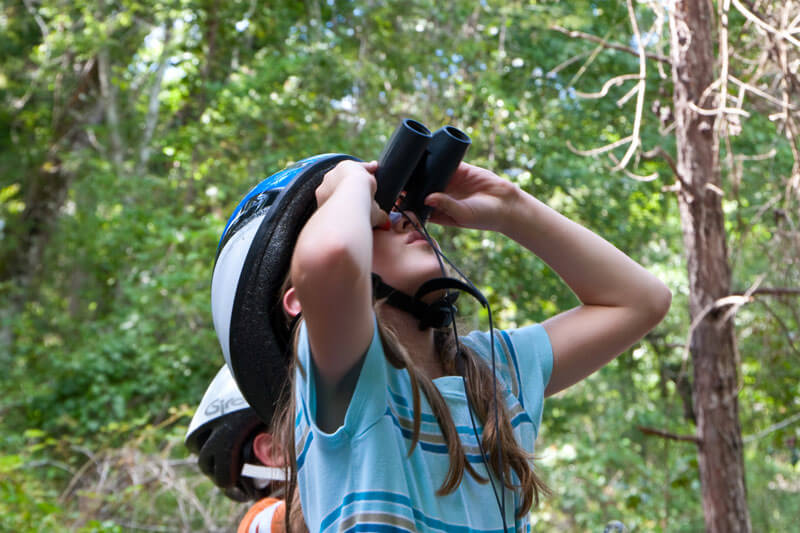
One suggestion to sample habitat and bird diversity is to head just south of Half Moon Bay on our coast. You don’t have to necessarily visit all of these places in one day, but you can visit each one across multiple visits and note which birds you see or hear. Then on another trip visit another point along this coast to a mountain area and note what you see there. That is the beauty of birding; you can return to the same place on a different date and you will see different things. Birds are not static, and as your knowledge grows you will see more species. You will also find that some birds are present nearly all the time, and some are less frequent. Predictability allows you to learn, the unpredictable nature keeps it fresh and exciting.
Some suggested trails for birding are:
Wavecrest Open Space Trail
The ocean and shore are a draw here, as is the coastal terrace of coastal chaparral and grasslands. Watch for Brown Pelican, Western Gull, Red-tailed Hawk, and Savannah Sparrow.
photo by K. Schneider
Burleigh-Murray Ranch State Park
This is a great mix of native riparian forest, mixed in with non-native species, in addition to dense chaparral scrub. Watch for Great Horned Owl, Olive-sided Flycatcher, Western Scrub-Jays, Spotted Towhee, and Wilson’s Warbler.
photo by Airplane Journal
Purisima Creek Redwoods Preserve
A wonderful stand of redwoods, deep and dark in shade, the habitat liked by Steller’s Jay, Pacific Wren, Brown Creeper, Townsend’s and Hermit warblers.
photo by albedo20
When Should You Look?
In short, always be looking for birds. Even when you are not on a specific nature outing, you can see birds. In parking lots, when walking your dog, and in your backyard or neighborhood. The more you pay attention, the more you become attuned, the quicker you begin to get those calming feelings of seeing nature all around you, not just in parks and open spaces.
But specifically, pay attention to the date. Some birds are resident, and some are migratory. There will be birds breeding in the redwoods in summer, that will be absent in winter. Similarly, some species arrive in winter and stay with us until spring rolls around and they head north. What species you see depend on the season, and the location and habitat. No matter when you go out during the day, there are always birds around. However, in the morning, birds tend to be more active. They are least active mid-day, particularly if it is hot and sunny. Mist, fog and even light rain can be fine for birding, but heavy rain or heavy wind really shuts down bird activity.
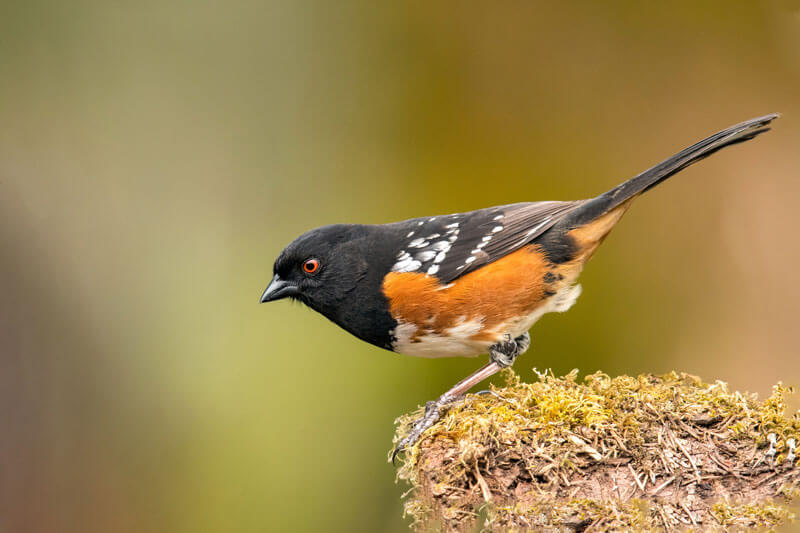
Who Are You Looking For?
When you begin, the birds that are easiest to see are the larger ones that are out in the open. Ducks on a pond, or big birds on the coast. Two species on the coast that should be easy to find are the Western Gull and the Brown Pelican.
The truth is that gulls are complex, as young ones are brown and many species look similar to each other. Yet the big Western Gull with its white body and dark blue-gray wings and back stands out. They have a bold banana yellow bill and tend to be darker above than any other white-headed gull. They live here year-round and are our “standard” gull on the coast.
The pelican needs no introduction with the unique big bill and pouch. Yet in the Bay Area, we have the more coastal Brown Pelican, unlike the American White Pelican that shows up mainly in sheltered water or fresh water. Brown Pelicans vary in coloration, some have white bellies, and some dark. This is age related, but still shape, size, and behavior allows you to know they are brown pelicans.
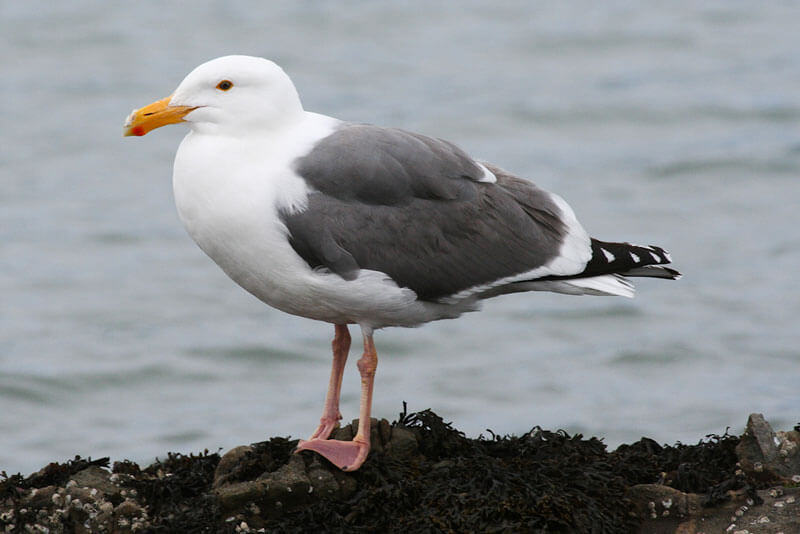
Crows and Ravens are obvious and big, and they are fully black so some people have a difficult time separating the two. Ravens are larger, they play in the air, and have very deep and raspy voices. Crows are smaller, give a nasal “caw” sound, and do not look hawk-like. They have a more subdued shape, while the raven has long and more pointed wings, and a tail that is diamond shaped, with the middle longer than the outer part of the tail. Training to look at the big picture and details at the same time is great for the mind and for focus and being in the moment. There’s nothing like trying to separate crows from ravens to get you there.
In the winter months, watch for sparrow flocks along the edge of chaparral or edge of forests. The big, bulky brown sparrows with a hint of yellow on the top of their heads, are Golden-crowned Sparrows. By April, they shift to a wonderful black, yellow, and white head pattern, and begin to sing a sweet series of clear whistles that sounds like “Oh, Dear Me…” with a distinct melancholy nature.
In summer in the redwoods, up high at the tip top you may hear the buzzy song of the Hermit Warbler. A little song bird with a bright yellow head. In winter they head south, but are replaced by flocks of a relative, the Townsend’s Warbler which has the yellow but a bold dark masked pattern on the face and extensive yellow on the breast.
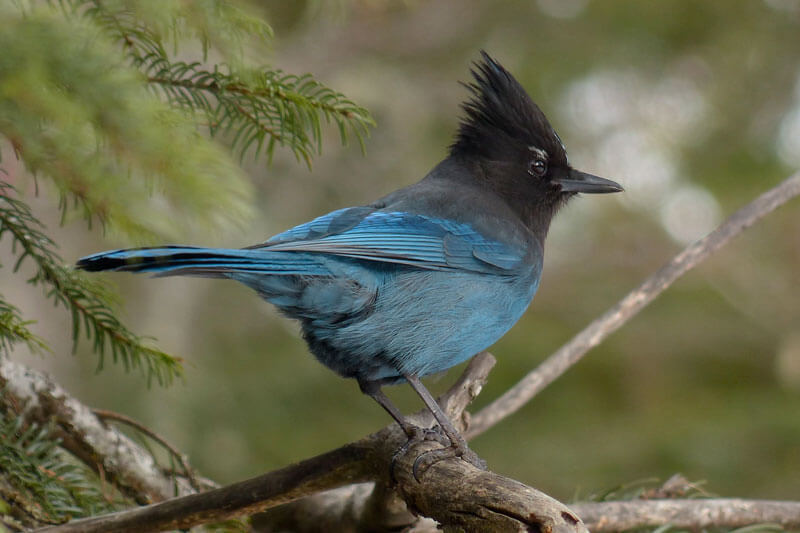
If you are not keen on birds in the treetops, you may notice a funny little brown bird that moves up the trunks of big redwoods, almost like a mouse-like woodpecker. It is the Brown Creeper. They almost look like bark, but their constant upward climbing behavior is key. When they reach high enough on a tree, they fly down low to the nest and begin another upward climb. They love big trees and shade, and the redwoods are key for them.
Now, if sometimes you just want to walk through the redwoods and listen to the birds, you will hear raucous calls such as that of the Steller’s Jay or its relative the Common Raven. However, you may also hear a bubbling, long, and convoluted song that is absolutely amazing and beautiful when you stop and pay attention to it. How can a bird make all of those sounds in quick succession? If you see the Pacific Wren, you will be impressed that such a tiny bird can make such a song. Pound for pound the most amazing singer we have in the forest.
photo by Alvaro Jaramillo
Need More Encouragement?
Birding does not replace hiking, photography, or other ways of enjoying nature. It is like a nice add-on to whichever ways you enjoy our public open space—you could even be listening to birds as you bike or ride a horse down a trail. You do not need to make a special time or place for it, you just have to decide to start paying attention. Just begin looking at birds, trying to determine what they are, and thinking about them. Once you begin to get that extra joy, that happiness from watching birds as you walk, you will wonder—what took me so long to do this? You will also wonder: how could I have gone through life and not noticed? It is an amazing feeling.
Meet the Birds
American Crow
American Crows and ravens are obvious and big, and they are fully black so some people have a difficult time separating the two. Crows are smaller, give a nasal “caw” sound, and do not look hawk-like. They have a more subdued shape than the raven.
photo by Alvaro Jaramillo
Brown Creeper
Brown Creeper is a funny little brown bird that moves up the trunks of big redwoods, almost like a mouse-like woodpecker. They almost look like bark, but their constant upward climbing behavior is key. When they reach high enough on a tree, they fly down low to the nest and begin another upward climb. They love big trees and shade, and the redwoods are key for them.
photo by Kelly Colgan Azar
Brown Pelican
The pelican needs no introduction with the unique big bill and pouch. Yet in the Bay Area, we have the more coastal Brown Pelican, unlike the American White Pelican that shows up mainly in sheltered water or fresh water. Brown Pelicans vary in coloration, some have white bellies, and some dark. This is age related, but still shape, size, and behavior allows you to know they are brown pelicans.
photo by Alvaro Jaramillo
Common Raven
Common Ravens are larger than crows, they play in the air, and have very deep and raspy voices. They look hawk-like with long, more pointed wings, and a tail that is diamond shaped, with the middle longer than the outer part of the tail.
photo by Alvaro Jaramillo
Golden-Crowned Sparrow
Golden-crowned Sparrows are big, bulky brown sparrows with a hint of yellow on the top of their heads in winter. By April, they shift to a wonderful black, yellow, and white head pattern, and begin to sing a sweet series of clear whistles that sounds like “Oh, Dear Me…” with a distinct melancholy nature.
photo by Alvaro Jaramillo
Hermit Warbler
Hermit Warblers are little song bird with a bright yellow head. In the summer, you may hear their buzzy song from up high at the tip top of the redwoods befre they head south in the winter.
photo by Frode Jacobsen
Pacific Wren
The Pacific Wren has a bubbling, long, and convoluted song that is absolutely amazing and beautiful when you stop and pay attention to it. If you see the Pacific Wren, you will be impressed that such a tiny bird can make such a song. Pound for pound the most amazing singer we have in the forest. Listen to the Pacific Wren's song.
photo by Alvaro Jaramillo
Townsend’s Warbler
The Townsend’s Warbler, a relative of the Hermit Warbler, has the yellow but a bold dark masked pattern on the face and extensive yellow on the breast. It takes the Hermit Warblers place in the redwoods during the winter.
photo by Alvaro Jaramillo
Western Gull
The big Western Gull stands out with its white body and dark blue-gray wings and back. They have a bold banana yellow bill and tend to be darker above than any other white-headed gull. They live here year-round and are our “standard” gull on the coast.
photo by Alvaro Jaramillo
More to Explore
- Watch The Birds of the Central Coast with Alvaro Jaramillo
- Read about marbled murrelets, the endangered seabird that nests in the redwoods, or watch The Marvels and Mystery of the Marbled Murrelet
- Check out hikes in Purisma Creek Redwoods Open Space:
Additional Resources
- Santa Clara Valley Audubon Society
- Monterey Audubon Society
- Watch Keep it Crumb Clean to hear about the effects of food in parks on corvids and endangered birds like marbled murrelets
